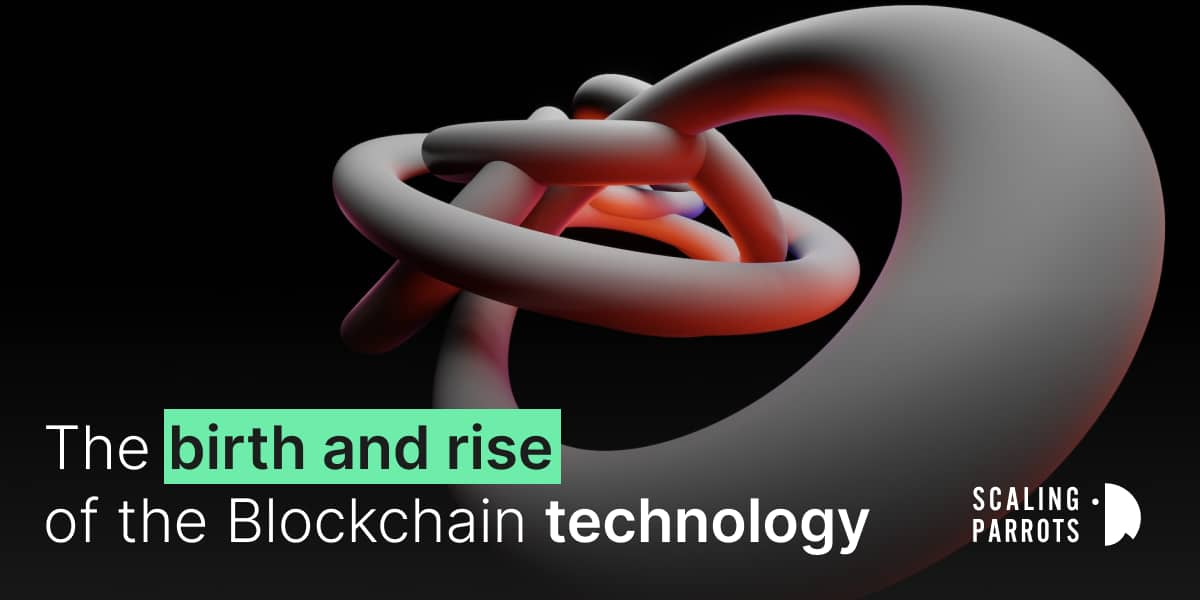
Blockchain is a digital ledger that records and keeps transactions that allow for person-to-person transactions without needing a third party or intermediary. In the 1990s, specific works appeared on decentralized solutions to make digital bills that do not require the intervention of any significant supervisory or regulatory entity.
The primary work on a consistent Blockchain using cryptography appeared in 1991 and progressed until 1998, when Wei Dai defined a decentralized solution for digital currency based entirely on public key cryptography.
This first work was created with the help of various authors until 2008; the thing that defines the mechanism to enforce a digital currency: Bitcoin, is posted beneath the pseudonym Satoshi Nakamoto. This is entirely based on the use of Blockchains to document transactions in a peer-to-peer network.
But there is more to Blockchain technology, and how it came about, this article will relate the history of Blockchain from 2009 till now.
Brief history of Blockchain before 2009
In 1991, Stuart Haber and W. Scott Stornetta had the foresight and ingenuity to create what became known as the Blockchain. Other pioneers of Blockchain technology include; David Chaum, a computer scientist and a cryptographer, and Wei Dai, the creator of b-money, who inspired the creation of Bitcoin by Satoshi Nakamoto.
Their first process resulted in a record on an encrypted Blockchain where file timestamps could not be tampered with. The device was updated in 1992 to include a more efficient Merkle tree and the ability to accumulate additional files in unbound blocks.
But it wasn’t until 2008, thanks to Satoshi Nakamoto’s appointment, that Blockchain talk gained traction, even in the eyes of people and institutions. Satoshi Nakamoto is widely regarded as the creator of the Blockchain era. Little is known about Nakamoto, who may be the person or group who worked on Bitcoin, the leading software of cryptocurrency.
Blockchain development stage in 2009
Satoshi Nakamoto published the first report in 2009. In the report, he described how Blockchain technology became well-prepared to improve digital trust, owing to the decentralization aspect, which meant that nobody could control or regulate anything.
Bitcoin was introduced in 2009 as a concept in a now-iconic white paper. The majority of people believe that Bitcoin and Blockchain are the same things. However, this isn’t always the case, as one is the bedrock technology (Blockchain technology) that powers the majority of applications, one of which is cryptocurrency.
Bitcoin emerged in 2009 as the first software of Blockchain technology. In his technical article, Satoshi Nakamoto defined it as a peer-to-peer (point-to-point) digital system. Nakamoto created the initial block, from which subsequent blocks were mined and interconnected, resulting in one of the most important Blockchains that deliver distinct portions of data and transactions.
The Bitcoin white paper, written under the pseudonym Satoshi Nakamoto, used Blockchain technology to create a Peer to Peer digital cash system, the first cryptocurrency of its kind.
In fact, Bitcoin as a cryptocurrency was the first use case for Blockchain technology. This device sought to disrupt institutionalized financial structures by allowing people to transact with one another without the need for a third party, such as a bank.
Development phase from 2010 onwards
2010
In 2010, Bitcoin, hosted by Blockchain technology, remained the prominent user of Blockchain technology. Blockchain technology achieved a milestone in its purpose when Bitcoin achieved its first fantastic retail transaction involving physical items, which was paid on May 22, 2010.
This was done by trading 10,000 mined BTC for two pizzas delivered from a nearby pizza-eating place in Florida, establishing May 22 as Bitcoin Pizza Day for crypto-fans.
At the time, the fee for a transaction was usually negotiated on the Bitcoin forum. On August 6, 2010, a critical vulnerability within the bitcoin protocol was discovered. While the protocol stated that a transaction’s outputs could never exceed its inputs, a transaction whose outputs totaled more than two could overflow, allowing the transaction creator to create an arbitrary amount of bitcoin.
On August 15, the vulnerability was exploited; a single transaction spent 0.5 bitcoin to ship just over 92 billion bitcoins (satoshis) to each of the community’s exclusive addresses. Within hours, the transaction was discovered, the malicious program was fixed, and the Blockchain was forked by miners utilizing an up-to-date model of the bitcoin protocol.
Since the Blockchain was forked due to the complex transaction, the transaction no longer appears within the Blockchain used by the Bitcoin community today. This became the only fundamental security flaw discovered and exploited in bitcoin history.

2011
Despite Nakamoto’s disappearance, Bitcoin’s trajectory remained consistent. By the end of January 2011, Bitcoin had been mined in the millions. Bitcoin’s price had reached parity with the US dollar by early February 2011.
Soon after, Jed McCaleb sold Mark Mt. Gox. Bitcoin quickly caught up with the Euro and British Pound. Wikileaks began accepting Bitcoin donations later that year. Mt Gox, on the other hand, was hacked and bitcoins stolen, resulting in overall value reductions and a trading halt.
Then, in October 2011, he introduced Litecoin, becoming one of the first Bitcoin spin-offs of which Blockchain remained the hosting technology.
Namecoin was also invented by Vincent Durham, which also acts as an alternative, decentralized DNS (Domain Name System).
2012
The bitcoin rate remained around $5 for the majority of the year, with many fluctuations. That same year, Coinbase raised more than $600,000 in a crowd-funded seed round, propelling it to the top of the bitcoin exchanges.
Peercoin PPC was also invented by Sunny king, which is hosted on Blockchain technology.
2013-2015
In a world wherein innovation is the order and demand of the day, Vitalik Buterin, an early contributor to Bitcoin’s codebase, is one of a growing number of developers who believe Bitcoin hasn’t yet crossed that threshold when it comes to utilizing all of the capabilities of Blockchain technology.
Concerned about Bitcoin’s limitations, Buterin began work on what he hoped would be a malleable Blockchain capable of performing various functions in addition to being a peer-to-peer network. Ethereum emerged in 2013 as a brand new public Blockchain with more capability than Bitcoin, a development that has proven to be a significant milestone in Blockchain history.
Buterin distinguished Ethereum from the Bitcoin Blockchain by allowing people to register in various assets such as slogans and contracts. The new feature accelerated Ethereum’s functionalities from cryptocurrency to a platform for developing decentralized programs.
Officially launched in 2015, the Ethereum Blockchain has grown to become unquestionably one of the most important Blockchain technology applications due to its capacity to assist intelligent contracts used to carry out various functions. The Ethereum Blockchain platform has also managed to attract a vibrant community of developers who have seen it grow into a true ecosystem.
Because of its capacity to support smart contracts and decentralized applications, the Ethereum Blockchain processes the most daily transactions. Its market capitalization has also risen significantly within the cryptocurrency space.
Also, in 2015, Linux Foundation released the open open-source in an Umbrella project 2015. They named it Hyperledger, which now serves as a collaborative improvement of distributed ledgers. Hyperledger, led by Brian Behlendorf, aims to strengthen collaboration with industries to improve Blockchain and distributed ledgers.
The focus of Hyperledger is to inspire the use of Blockchain technology to improve the overall performance and reliability of modern structures to aid enterprise transactions worldwide. Other cryptocurrencies that were launched in this period include; Dogecoin, Gridcoin, Ripple, Dash, NEO, Stellar Vertcoin, and a host of others.
2016
In 2016 the Blockchain as a terminology was accepted as a single word rather than two concepts as they were presented in Nakamoto’s report.
There was a movement by the Chamber of Digital Commerce and the Hyperledger project to enhance Industry Advocacy and Education.
A hard fork of the Ethereum network was formed due to a bug in the Ethereum decentralized autonomous organization code which was hacked.
Also, FIRO and Zcash cryptocurrency was launched on the Blockchain platform.
2017
This year the government of Japan accepted Bitcoin as a legal currency. Bitcoin reached a record high of nearly $20,000.
And the Digital Trade Chain consortium was formed by seven European banks to develop a Blockchain-based change finance platform.
EOS, the brainchild of personal company block.one, was born in 2017, inside the book of a report detailing a brand new Blockchain protocol powered by EOS as the local cryptocurrency. Unlike other Blockchain protocols, EOS attempts to emulate characteristics of actual computers, such as CPU and GPU.
As a result, EOS.IO functions as both a smart settlement platform and a decentralized operating system. Its primary goal is to sell the deployment of decentralized programs through a self-sufficient and decentralized organization.
Block.one introduced the EOS Blockchain operating system, which is intended to guide decentralized business applications. Cryptocurrencies that were launched on the Blockchain platform in 2017 include; Cardano, TRON, and Bitcoin Cash.

2018
This year marks the tenth anniversary of Bitcoin. Bitcoin’s price continued to fall, finishing the year at around $3,800.
Stripe, an online payment company, has stopped accepting bitcoin payments. Google, Twitter, and Facebook have all prohibited cryptocurrency advertising.
South Korea has prohibited the purchase and sale of anonymous cryptocurrency but has announced that it will invest hundreds of thousands of dollars in Blockchain innovations.
In the same year, the European Commission launched Blockchain Observatory and Forum.
And Baidu has launched a Blockchain-as-a-service platform.
2019
In 2019, Walmart unveiled a supply chain system built entirely on the Hyperledger platform. Amazon announced that its Amazon Managed Blockchain network is now available on AWS.
The Ethereum community transactions reached 1 million per day. And Blockchain research and development reached a tipping point as organizations embraced Blockchain generation and decentralized applications for a wide range of applications.
2020
According to Deloitte’s 2020 Global Blockchain Survey, nearly 40% of respondents integrated Blockchain into production, and 55% regarded Blockchain as a top strategic priority.
In preparation for Ethereum 2.0, Ethereum implemented the Beacon Chain. Stablecoins experienced a significant increase because they promised greater stability than traditional cyber currencies.
2020 saw that combining Blockchain with AI to optimize commercial enterprise processes has become a growing hobby. 2020 also saw the launch of Avalanche and Shiba Inu cryptocurrency in the Blockchain platform.
2021 – 2022 Blockchain Era
In November 2021, the price of Bitcoin reached an all-time high, exceeding over $68000.
There was also a boom in the crypto world where other cryptocurrencies, such as Ethereum, reached their all-time high record.
SafeMoon and Internet Computer ICP cryptocurrency was launched.
In the year 2022, there are ups and downs in the crypto space where so many crypto exchanges filed for bankruptcy, resulting in a downward stride in the value of most cryptocurrencies.
Despite this downward stride in the crypto space due to fluctuating prices, so many other platforms are still queuing into Blockchain technology and forming their cryptocurrency.
Blockchain continues to be a force to reckon with as so many sectors are now keying into the Blockchain.
Blockchain history and the future
New projects have attempted to address some of the shortcomings of Bitcoin and Ethereum and provide new functions that leverage Blockchain capabilities. To accelerate the development of the Internet of Things, a few developers took advantage of Blockchain generation and created IOTA (a network that helps investors and companies monetize data feeds from the IoT) within the system.
It also addresses a number of the scalability issues associated with Blockchain.
The Monero, Zcash, and Dash Blockchains arose to address some safety and scalability issues associated with early Blockchain applications. All three Blockchain structures, dubbed Privacy Altcoins, seek to provide high transaction privacy and security levels.
Companies like Microsoft appear to have taken the lead in exploring Blockchain generation programs that translate into private, hybrid, and federated Blockchains.
Blockchain technology’s future appears bright, partly because governments and organizations are investing heavily to stimulate its improvements and applications. It is becoming increasingly clear that there may eventually be a public Blockchain that everyone can use.
Proponents hope Blockchain technology will aid in automating most responsibilities handled by specialists in all industries. The technology is already being used effectively in supply management and within the cloud computing enterprise.
As the era progresses, Gartner Trend Insights predicts that at least one Blockchain-based enterprise will be worth more than $176 billion by 2025 and exceed $3.1 trillion by 2030.
Conclusion
Approximately 15% of the world’s banks used Blockchain technology in some capacity. Researchers are currently experimenting with different versions of the basic Blockchain structure.
Popular Blockchains perform well beneath light loads but have difficulty scaling and supporting full-scale applications. Transaction costs skyrocket, while processing times range from hours to days. Many of the newest Blockchains include innovative solutions to these issues.
Researchers are still experimenting with consensus mechanisms, parallel sub-chain coordination, personal Blockchains, and other technical issues. Most new cryptocurrencies are introduced to help specific programs or industries rather than to serve as all-purpose replacements for government-issued fiat currencies.
Many of the newest Blockchain applications have nothing to do with cryptocurrencies. These programs may occasionally benefit from changes to the Blockchain’s fundamental structure.
Even if governments around the world legislated the abolition of the cryptocurrency market, Blockchains could continue to serve important functions in fields such as healthcare, identification management, supply chain management, and entertainment, amongst others. Blockchains have come to stay.
See you soon,
Scaling Parrots
